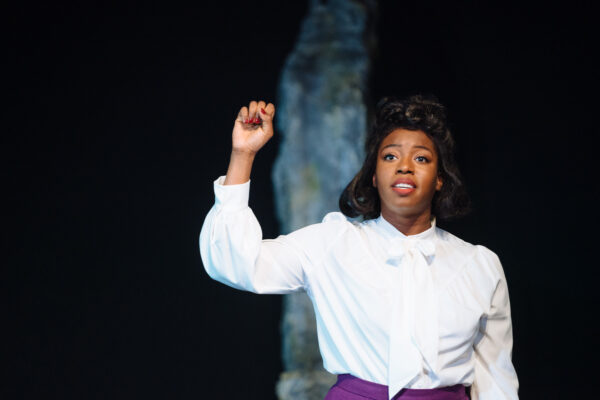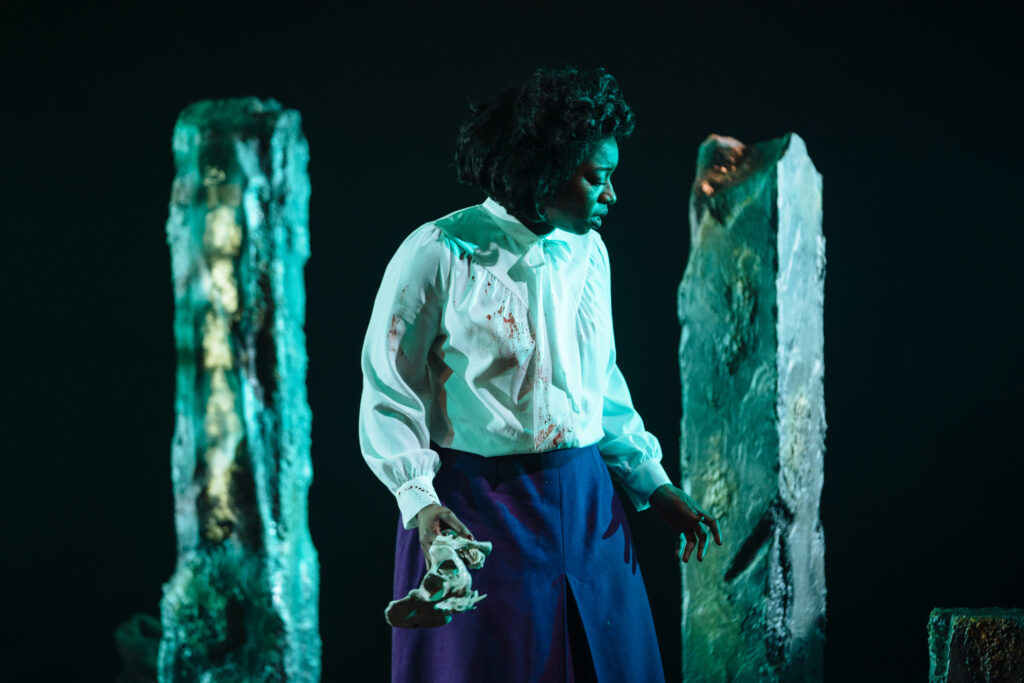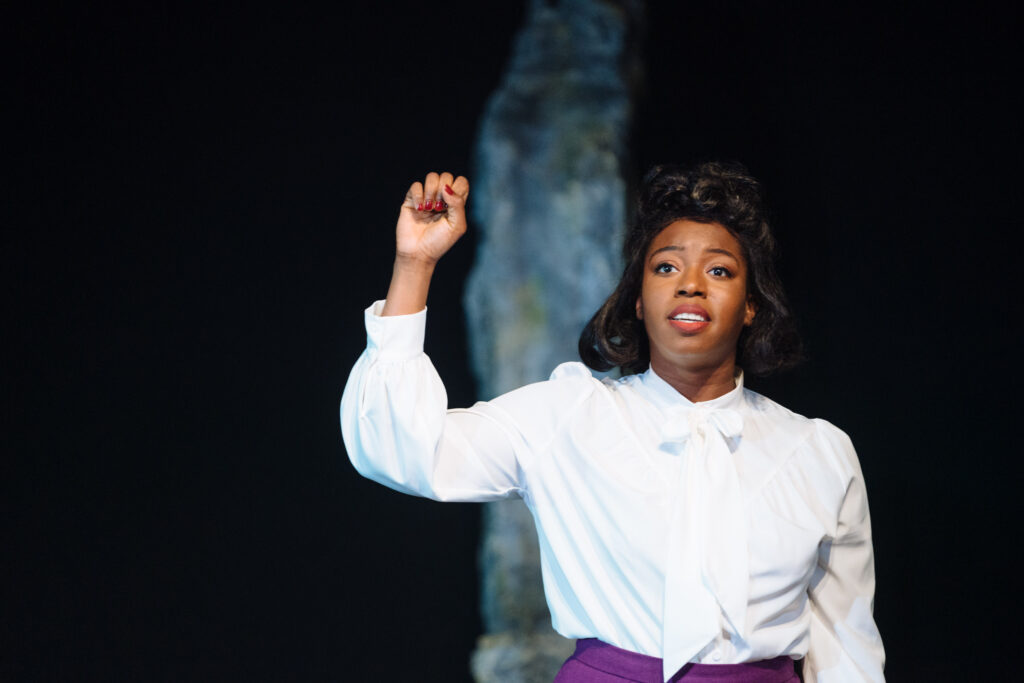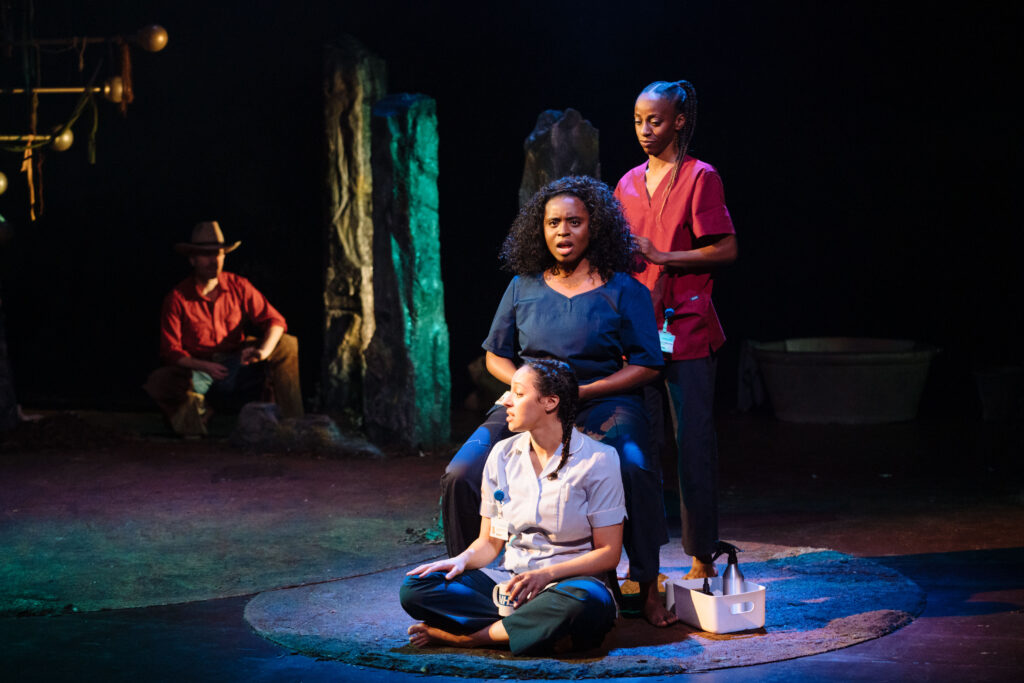6th November 2023
Listen
Listen

TW: discussion of non-consensual medical experiments on Black women, as well as cancer.
Family Tree, presented by Actors Touring Company and Belgrade Theatre Coventry, in association with Brixton House, was performed at the Everyman on the 5th of May. In this play, by Mojisola Adebayo, Henrietta Lacks is re-written into history and the life-changing legacy of her cancerous cells is finally brought to public recognition. Her legacy transcends into modern medicine and her forgotten Black body is paralleled in the non-consensual experimental surgeries in the research of gynaecology. Family Tree even draws on our present-day, post-pandemic, Covid-19, through the frustration and exhaustion of Black women working in the NHS.

Credit and copyright: Helen Murray www.helenmurrayphotos.com
Mojisola Adebayo transforms Henrietta Lacks (Aminita Francis) into immortality, by allowing her to narrate her own tale, something she was previously denied. Family Tree reveals the public’s ignorance of a medical history which has benefited practically the entire world. The performance invokes a sense of privilege; I’m sure few people are familiar with Henrietta Lacks and her background, as well as the history of Black women who had gynaecological procedures without consent or pain treatment.
Family Tree opened with the promise of a space for Black women to finally express their versions of history, in particular the story of Henrietta Lacks. No longer does she live under the pseudonym Helen Lane and no longer is her story kept hidden. The play deals with the vicious discrimination that ultimately resulted in Henrietta’s cells being utilised in research, without her permission – leaving her family not only bereaved of their beloved wife and mother but impoverished. Knowing the identity of her cells would have not only saved the lives of millions of others but also her family. Aminita Francis is moving and sincere in her performance, she is not merely an actress playing a role but also a spokesperson for the telling of Henrietta Lacks’ story, which she so deeply deserves.
The performances of Mofetoluwa Akande, Keziah Joseph and Aimée Powell as ancestors and nurses, were incredibly moving. Their roles as NHS nurses (Ain, Bibi, Lyn) exposed the tiredness and treatment faced during the pandemic and particularly the mortality rates of Black women in labour. Switching to earlier times, the three women (Anarcha, Betsey, Lucy) show the brutality and completely dehumanising exploitation of Black bodies in gynaecology, research which has influenced our modern world of medicine. Each of the women’s stories is intrinsically laced with the power of nature, captured in a powerful scene where Henrietta and the tree engage in a confrontation. Ultimately, the play outlines a Black female movement, of which each actress performs and delivers incredibly.
A smoking cowboy (Alistair Hall) haunts and invades the immortal realm inhabited by the female Black characters throughout the performance. He is accompanied by the sound of an intense and chilling whistle and the progression of the play sees his demise, eventually dying in the arms of the women. His burial, to me, defines the message of the play – that the power of words and story-telling marks the beginning of the end for the white supremacy that has silenced and falsified history for so long. Finally, women like Henrietta Lacks can begin to rest. Anger festers into pride and a means for celebration through this recognition, particularly presented at the end of the play in Mofetoluwa Akande’s part as Oshun.
Although the play deals with extremely traumatic events and confronts positions of privilege, the production is laced with humorous references, filled with music (notably Beyonce and Cardi B) and dancing. It was inspiring watching historical Black women’s lives fill that of audience members, which frequently resulted in participants openly agreeing and nodding their heads in a shared empathetic relation. The interlinks between Toni Morrison and her novel Beloved were, for me, some of my favourite moments within the play. The message of confronting past trauma to be able to move on to the future, through the means of community, was captured here. Adebayo writes a compelling and poetic story, and I can honestly say that I was truly educated and believe that it is strongly deserving of continued attention.

Credit and copyright: Helen Murray www.helenmurrayphotos.com
The set of Family Tree is a nod to the subjects dealt with during the play. Simon Kenny creates immortality on the stage. Henrietta, much like her cells, lives in this place that is neither presented as Heaven nor Hell. In there, lives the memories of NHS nurses and Black women who endured gynaecological research surgeries. The stage creates a space where they no longer physically exist in the present day, but immortally exist through their experiences that significantly mark history.
The circular forest floors evoke the image of a petri dish, in which Lacks’ immortal cancerous cells lived. Perhaps it is also an inference towards her ‘pearl-like’ tumours found on her cervix. Nevertheless, the iconography is powerful in its interpretation of Henrietta and her history being incorporated into everything and ultimately within nature also. Stones stand tall, scattered across the set, suggesting the women’s solidarity and ownership in their place and belonging in history. However, I did feel that the colours were perhaps more mundane and dystopian rather than somewhere that presented the immortality of Henrietta and her legacy.
With Henrietta working on a tobacco farm and Anarcha, Betsey, and Lucy working on a plantation, natural imagery is fitting. The naturalistic setting echoes how Black bodies were ‘farmed’ for medical research. The DNA-strand-like tree served to promote Henrietta and her life-altering cells – essentially she shares her DNA with millions through treatments for cancer, HIV and even coronavirus vaccinations. The unexpected confrontation between Henrietta and nature was performed through a series of green flashing lights and an echoing voice-over conversing with Henrietta.

Credit and copyright: Helen Murray www.helenmurrayphotos.com
Composer and Sound Designer, Francesca Amewudah-Rivers and Sound Associate, Clive Meldrum achieve a great composition of sound from selections of modern hip-hop and rap. Birdsong compliments the majority of the scenes, immersing the set into a more naturalistic, outdoor setting. For me, the coughing of the smoking cowboy was perhaps slightly too emphatic and overwhelmed the space though. The sound overlay during the scene in which the tree gains a voice is cathartic and demonstrates a great sense of power. Overall the sound devices throughout the play were good.
A melody of lighting is created by Lighting Designer Simisola Majekodunmi and Lighting Associate Tom Lightbody, to define day and night, whilst being reflective of the mood of the scene at hand. The green light sequence that travelled through the tree was interesting and intense and truly emphasised a theme of power in Family Tree. I enjoyed the use of split-stage lighting to draw focus on shifting periods that are, in the end, inherent to one another.
Also a notable mention to the costumes of the play that captured the different roles and time periods, particularly Henrietta’s purple suit and its stimuli of cancer but also of wisdom and a connection to nature.
Family Tree will be touring until the 10th of June 2023.
An online program can be found here: https://www.atctheatre.com/wp-content/uploads/2023/04/DIGITAL-PROGRAMME-FAMILY-TREE.pdf
A full cast list can be found here: https://pdfs-of-qr-codes.s3.amazonaws.com/bb18cb5e31a85341ab99f63770610258.pdf
Cover image by Helen Murray, used with permission.